Alex P. Berg's Blog
February 28, 2025
A Four Year K-Pop Introspective
I started listening to K-Pop during the pandemic, probably around September of 2020. The first K-Pop song I heard was K/DA’s “Pop Stars,”* a promotional song put together for the 2018 League of Legends World Championship featuring a pair of K-Pop singers alongside two Americans. I was blown away both by the song and the video, which featured super slick animation among some cool visual concepts, but the video alone didn’t immediately sell me on K-Pop. In advertising, it’s said that a consumer needs to see your brand seven times before making a purchase, and this was my first time setting eyes on the brand, so to speak.
(*Ok, this isn’t technically true. I saw Psy’s insane “Gangnam Style” video back in 2012, same as everyone else, but at the time I treated it as a meme/viral sensation rather than thinking of it as K-Pop.)
Regardless, that K/DA video broke the ice. It put K-Pop on the map for me, so that when I chanced across an article about a K-Pop band that was breaking molds by being a mixed gender group (gasp!), I read it. I started listening to more bands, enjoying the diverse mix of singing and rapping and the meticulously choreographed dancing in the music videos. I found YouTube channels devoted to K-Pop, which helped expose me to bands other than the handful of super popular groups I’d already found on my own, and I watched a YouTube documentary about K-Pop to better understand the history of the genre.
Fast-forward to today, and my K-Pop playlist has ballooned to over a thousand songs. Not only has the genre claimed meas a fan, but it continues to spread further and further into the mainstream. K-Pop songs are getting regular airplay on American radio stations, both full songs by K-Pop groups as well as solo artists who have started recording songs specifically for English-speaking audiences (Jennie, Rosé, and Lisa of Blackpink come to mind). Given the fact that I’ve come to love this genre, I wanted to share with you some of my favorite artists as well as some stats from my playlist in the hopes that maybe you’ll find something to love here as well.
Side Note: While a lot of these songs contain some English, the majority of the songs are sung in Korean, and if you’re not a Korean speaker (like me), you may want to mark subtitles on for any of the videos I’ve linked. Or you can simply enjoy the dancing and choreography and worry about understanding the songs at a later date.
Total Playlist Length: 1016 songs – 2 days, 5 hours in lengthMost Listened to Song: “More” by K/DA. This is partially a function of being one of the first K-Pop songs I added to my playlist, but mostly it takes the top spot because it’s an amazing track.Favorite Boy Groups: Stray Kids tops the list for me, a hard-hitting group with some obscenely talented rappers and great song production (“God’s Menu” is a must listen). Seventeen and Ateez are also high on my list.Favorite Girl Groups: Itzy wins out by a smidge, as their songs have the catchiest melodies for me (I recommend “Not Shy”). TWICE has also really grown on me over time, and (G)-IDLE are probably the most visually and musically creative group (“Oh My God” is a good example). Blackpink and Aespa get honorable mentions.Favorite Male Solo Artists: BTS’s Suga, who releases solo songs under the name Agust D, is really dang talented. “Daechwita,” which features traditional Korean instruments and costuming, is a must listen. Jay Park (hip-hop/R&B) and Kai (pop) are others I like.Favorite Female Solo Artists: Chung Ha, hands down. She does a lot of electonica, but I prefer her songs that lean into hip-hop and R&B (“Eenie Meenie” is a good example). Hyolyn and Taeyeon are also worth a mention, as well as Bibi, an outside-the-box K-pop artist who is uber talented (seriously, this “Life is a Bi…” video is so odd, but the song is so catchy at the same time… very compelling).Favorite Mixed Gender Group: KARD. Kind of a cop-out, because they’re the only mixed gender K-pop group that I know of, but I do really like their music. (“Hola Hola” is a fun, simple song.) I don’t know why nobody else has put together a mixed gender group, honestly.Favorite Virtual Group: K/DA. For those wondering, a virtual group is one where the members are always depicted by animated characters or avatars. (Think The Gorillaz). This one’s actually not a cop-out answer, because for some reason there are a lot of virtual groups in K-Pop.Favorite K-Pop Group that isn’t really K-Pop: XG. The reason they’re not K-Pop is because all the members are Japanese and they sing exclusively in English, but they’re based in South Korea, are produced by a Korean music company, and their songs are structured like K-pop from a melodic and vocal standpoint. Hard to pick between “Left Right,” an ode to 90’s R&B, and “Woke Up,” a fierce rap anthem, as my favorite songs.First Boy Group I became a fan of: Probably BTS? I mean, they’re the most well-known K-Pop group, and as a result were one of the first groups I started listening to. (“Dynamite” is arguably the first K-Pop song to achieve wide-spread commercial success in the US). GOT7 is another group I found early on that I quickly liked.First Girl Group I became a fan of: Blackpink and ITZY, but since I already mentioned them, I’ll add Mamamoo (pop/R&B) and Red Velvet (pop/electropop). Since I somehow haven’t linked any Blackpink yet, I’ll just drop “Ddu-Du Ddu-Du” here for your listening pleasure.Newish Boy Groups I like: Blitzers. Seriously, listen to “Macarena” and tell me it’s not a total bop. I also want to mention P1Harmony and Treasure, but neither of them are really that new.Newish Girl Groups I like: A tie between Babymonster (their debut “Batter Up” is a banger) and Le Sserafim (their song “1-800-hot-n-fun” was censored when they went on US late night shows because the number is a phone sex line), but I’d be remiss in not mentioning Young Posse, a rap-centric group that is criminally underrated. (Their song “Ate That” is the most perfect example of G-funk since Dr. Dre and Snoop Dogg were releasing songs in the early 90s.)Favorite Rappers: (G)-IDLE’s Soyeon is amazing and would clearly be the best rapper in K-Pop if not for the emergence of a young lady by the name of Lee Young-Ji. She’s the only female winner in eleven seasons of rap reality show Show Me the Money, and her speed, fluidity, and the timbre of her voice make her unmistakable. She mostly does cameos on other people’s songs as she’s still sorting out her solo career, but her rap on Mark’s “Fraktsiya” is emblematic of her talent. On the men’s side, other than the aforementioned Suga, I have to mention Stray Kids’ Changbin and Han. They are the best of the best. (Lots of songs to choose from, but “Megaverse” comes to mind as a great example).Favorite Singers: Of the ladies, Blackpink’s Jisoo has an angelic voice. Mamamoo’s Solar is technically excellent, but I’m partial to Aespa’s Ningning (listen to “Bored”). Also, Bibi does this sort of whisper-talking thing that’s compelling. Of the men, BTS’s Jungkook is very good. EXO in general was a very good vocal group, with Baekhyun standing out, and there are a lot of great vocalists in Seventeen (I’d name them, but frankly there are too many members in the band and they tend to blur together. The b-side “Habit” showcases their talent as a unit).Finally, I’d be remiss not mentioning Stray Kids’ Felix, whose ridiculously deep voice makes him stand out in every song he sings.Band who disbanded that I wish was still active: I would’ve mentioned GOT7, but they recently got back together, so I’ll pick CLC, a talented girl group that never seemed to get much of any support from their production company (“Helicopter” is one of their best). What I’d like to see from K-Pop moving forward: Adoption of more musical genres, continued evolution and creativity of musical composition, more artists being actively involved in the song composition process, and more mixed gender groups, for crying out loud!I think that’s about it. Hopefully you found something new that speaks to you out of my recommendations, and be sure to let me know some of your favorite songs and artists in the comments!
The post A Four Year K-Pop Introspective appeared first on Home of Alex P. Berg.
May 21, 2024
Can You Use Generative AI Ethically? I Mean…
I recently saw a Threads post by well-known author and purveyor of writing advice Chuck Wendig (a zombie post resurrected from late 2023—not that it matters) in which he trashes people using AI and finishes with: “AI in creativity is for the people who have no skill, no work, no effort, no ethic. They just want to push a button.”
The reason I saw said post was because a Facebook acquaintance—someone who creates both writing and visual art—was extremely offended by said statement, going on to outline how they use AI “ethically” in their creative process. I put ethically in quotes, not as sarcasm, but because I don’t think they used the word. I’m simply paraphrasing their argument that AI can be used as a productivity tool to boost the creative process.
So who’s right? As with most topics, this isn’t a black and white affair. There’s nuance, which people usually avoid when limited to 280 characters or whatnot, but I tend to think Chuck is more right than wrong, and here’s why.
Let’s start by outlining what I consider to be the five types of generative AI users. These groups apply to people using any kind of generative AI: writing, visual art, music, video, whatever. The groups are the same. They are:
1) The Dabblers: These are folks who stumble across generative AI and think, “Ooh! That’s cool.” They generate a few images, or a 500 word short story, or a song, but they don’t do anything with it. They’re just interested in what the technology can do. They’re not there to monetize it or take credit for the result. It’s just a cool toy, one which gets old fast. (Full disclosure: I fell into this group at first, in December of 2022, for about a month or so. You can scroll through my Facebook feed and find the posts.)
2) The Workflow Gurus: These are creatives who see AI as a way to streamline whatever it is they do, whether it be writers who get stuck during the outlining stage, artists who need help with posing or proportions, musicians who use AI to create catchy baselines and then add their own instrumental or vocal tracks on top. These are folks who have accepted that AI is here to stay and are trying to make the best of it, or folks who legitimately love that they can do more with less. And they don’t really think of the AI portion of the contribution as “not theirs.” They treat it like a Creative Commons license. They added and remixed on top of the AI contribution, creating something entirely new and unique as a result.
3) The Hustle Culture Bros: These are the people who see AI as a way to make a quick buck. If there’s a way to exploit a loophole in the system and commoditize art, they’re going to take advantage of it and run that revenue stream into the ground. These are people who spam Amazon’s kindle store with incomprehensible books full of garbage and then use click farms to make money off Kindle Unlimited. These are the people selling tens of thousands of AI generated images to stock photo sites. The people uploading AI generated images of log cabins and fake fitness influencers and Shrimp Jesus (for some god-forsaken reason) to Facebook, all in the hopes of generating clicks and video views to generate ad revenue. This stuff is 100% garbage, and it’s pervasive.
4) The Pyramid Schemers: You could probably lump people in with the Hustle Culture Bros if you wanted to, but these folks are going one step further: Selling courses to teach you how with seven simple steps, you too could be making $24,000 per month selling AI bullshit. Are they pushing AI garbage directly? Maybe not. But they’re selling the secrets to unlocking untold wealth with AI, and thereby vastly increasing the amount of AI bullshit online. If your Facebook feed is anything like mine, these people are EVERYWHERE. To be fair, the scammy course sellers aren’t limited to AI, but as with crypto, there’s a lot of overlap between them and AI in the Venn Diagram of scam bullshit.
5) The Institutional Users: These are folks who are being paid by corporations to generate whatever AI garbage they need: artwork for ads or websites, blog content, recipes, sports articles, you name it. These are the mythical PROMPT ENGINEERS, a term which has supplanted Sanitation Engineer as the most insulting fake work title. (At least with janitors, Sanitation Engineer was mostly a joke, but companies want you to believe that Prompt Engineers are a real thing and not just “guy who types thing into ChatGPT”). These are jobs that have replaced real artists and creatives, wholesale at some companies. Many companies have already cut their entire creative teams and replaced them with one or two minimum wage Prompt Engineers.
There may be some groups I missed, but these are the main ones. I don’t claim to know how many people are in each group, but for the sake of argument let’s say each group contains similar numbers of users (which I doubt, but let’s roll with it). Does that mean 3/5 of all AI generated content, that from the latter three groups, is trash? Of course not. Because the Hustle Culture Bros and Institutional Users are creating ORDERS OF MAGNITUDE more trash then the other two groups. They are flooding every medium possible with garbage, because that’s their business model. As Chuck Wendig writes, these are people with “no skill, no work, no effort, no ethic. They just want to push a button.” (Well, they actually do put in work, but not in regards to creating. Just to squeezing every last dime from the fractured system around us).
At this point, if you’re one of the Workflow Gurus, you might be thinking, so what? I’m doing things the “right way.” What does it concern me if these other scammy lowlifes are abusing the technology that I’m using to facilitate my process? Well for starters, all those scammers and hustlers are making it much, MUCH harder to monetize your work, or even get any eyeballs on it. If every online medium has been flooded with a sea of raw AI sewage, do you think anyone is going to notice your nice creative tart floating in the frothy morass? Not likely. And depending on what you’re selling, many potential buyers are already out of the market, having switched from purchasers of creative goods to generators of mediocre crap. Do they know it’s crap? Yes. Do they care? No. Because we live in a capitalist society, and as long as that mediocre crap is substantially cheaper than the quality creative stuff that came before it, the crap will win.
So yes, I was a dabbler in AI, and when the image generators came around, I did think they were cool for a few weeks. But I quickly realized the harm they were doing, and I think Chuck is (mostly) right. AI does WAY more harm than good, and the little good it does is made practically irrelevant by the harm.
One last point, for my author friends: Even if you’re part of the Workflow Gurus, or someone who uses AI to improve their craft and tries to use AI in a positive, beneficial way, if you’re using generative AI in ANY way other than to replace work you yourself did, you’re hurting your fellow creatives. If you used to buy covers from artists and now use AI, you’re hurting artists. If you used to hire an editor and now use AI, you’re hurting editors. If you used to hire a translator and now you use AI, you’re hurting translators. Regardless of how you feel about AI, it’s putting people out of business. So don’t be surprised when someone who otherwise might’ve come to you to buy something decides to go to AI instead…
The post Can You Use Generative AI Ethically? I Mean… appeared first on Home of Alex P. Berg.
May 30, 2023
Why Indie Publishing Feels Harder Than It Used To
So I recently read a post by Chuck Wendig entitled “The State Of Being A Published Writer In 2023 Is Really Weird, And A Little Worrisome,” and it struck a chord with me. To be clear, Chuck’s a traditionally published author. His insights, which I highly suggest you read, deal with trad publishing and bookselling as a whole, but he alludes that his indie friends are feeling the pinch as well.
If I’m being honest, that resonated with me, because I’ve felt for a while now that self publishing… well, not that it’s dying, just that it’s a lot harder to succeed in the space than it used to be. Whereas once self-publishing felt like a world of opportunity, now certain factors are making it feel more and more like a mirage.
Why is that? Chuck didn’t go into detail because he doesn’t have perspective into the indie world, but as someone who’s been doing the self-publishing thing for almost a decade, I have a few thoughts on the matter. All of the following are my opinions, so take everything I say with a grain of salt.
Amazon Owns the TownThe Amazon Kindle was first released in November of 2007, and while the device has come a long way since then, that initial piece of tech launched the self-publishing revolution. To be clear, self-publishing has existed for as long as the printing press has, but in a print world, self-publishing meant ordering a full run of a novel from a printer and hand selling your books to stores, schools, or directly to buyers. It wasn’t a viable career option so much as an expensive, time-consuming way to purchase kindling. The self-publishing revolution was actually enabled because of the ebook revolution. The internet opened a new avenue of distribution for authors, one which didn’t require them to spend thousands of dollars and fill their garages with books to get started, and the Kindle gave tech savvy early adopters a way to read books by folks whom they might never otherwise have found.
While New York publishers and traditionally published authors would thumb their noses at self-publishing for years, risk takers found pay dirt. Hugh Howey was one of them. Wool, published in 2011, earned Howey enough to build his own trans-Atlantic sailboat, and it was recently turned into a critically-acclaimed series on AppleTV. I personally began self-publishing at the tail end of 2014, and I found immediate success. At the time, it felt like as long as you had a great book with a good cover and a catchy blurb, Amazon would place your book in front of reader eyeballs and you could easily start selling books, which… is not the case anymore.
In those days, it was all about appeasing the Amazon ALGORITHM. Why do I write ALGORITHM in all caps? Well, because the ALGORITHM has a bit of a mythological status among indie authors. It’s the God of Amazon: the inscrutable being in charge of which books live or die, who succeeds and who doesn’t, and everyone had their own theories about what you had to do to get it to notice and promote you. Because make no mistake: if the ALGORITHM chose you, you could start selling beaucoup books, and you didn’t really have to do anything other than keep publishing great books to keep the gravy train flowing.
In fact, Amazon’s ALGORITHM was what the whole company was founded upon. Its purpose was simple: get the best possible item a buyer wants in front of their eyeballs as seamlessly as possible. Makes sense, right? If you want to create a great customer experience, you want people to buy products they’re going to love. This worked with all manner of goods, but books especially. If you were really into urban fantasy books featuring female leads and lots of steamy romance, the ALGORITHM would realize that, and every time you’d start looking at books, a carousel of similar novels would bepromoted to you. Awesome! The ALGORITHM worked, but while it was effective at providing a good customer experience, it wasn’t the best at providing a profitable experience for Amazon.
So over time, Amazon made the ALGORITHM less important, replacing most of its recommendations for books or toys or poorly fabricated widgets to PAID ADVERTISING. (I’m capitalizing that one just this once, for funsies). Paid advertising dominates Amazon now. Just about every product you see, from the main page to search results to “Books you may like” carousels are from paid advertising. Unless you’re browsing an active bestseller list, there’s a good chance whatever book Amazon is showing you was paid to be on the screen, not because the ALGORITHM decided you’d like it.
Which, obviously, makes for a worse customer experience. I don’t want to buy some crappy book someone is shilling. I want a book that fits my specific interests. The ALGORITHM knows what I want, but it generally won’t show it to me anymore because it earns Amazon more money not to, at least in the short term. Eventually, buyers will realize the Amazon customer experience isn’t very good anymore and they’ll move elsewhere, or at least they would if they weren’t locked into Prime subscriptions and dependent upon Amazon’s lightning fast delivery network, which is really what the company thrives at nowadays.
But paid advertising isn’t the only way Amazon has squeezed authors. Remember Kindle Unlimited, Amazon’s all-you-can-read subscription service? It’s a great way to get the ALGORITHM to pay more attention to your books, but only if you make them exclusive to Amazon. And while the rates they pay for each page read have always been low, lately they’ve been getting worse, and worse, and worse…
As it pertains to authors, Amazon has essentially become the old west company that owns the gold mining town. They force you into exclusivity, pay you a pittance, and if you want people to actually discover your books? You’ve got to pay for that privilege, too. Every day, Amazon finds new ways to force authors to pay a little bit more for the privilege of reader eyeballs, leaving authors with less and less.
In case you hadn’t noticed, social media is a total dumpster fire right now. Like absolute hot, steaming garbage. Facebook has been for years. If you’re able to find even one substantive post hidden among the piles of ads, memes, click-bait videos, and political arguments before you chuck your phone out the window screaming, you have a stronger stomach than I do. For a long time Twitter seemed like a fun, bite-sized alternative, but ever since Elon took over, a fetid deluge of sexism, racism, Nazism, and all of your other least favorite isms has backwashed in, not to mention the site is plain broken a lot of the time. Instagram maybe is the last major social media site standing, but unless you happen to be a fitness model or an inanimate object that’s actually cake, good luck finding any traction there.
Although, there’s also TikTok. I mean, BookTok is a thing, right? It’s how books go viral and find readers now. Except most big Booktokers (is that a word?) are paid influencers, too, and many of them charge thousands of dollars to hawk novels to their audiences. Sorry to burst your bubble, but most of those viral BookTok successes are actually manufactured with cold hard cash.
But who cares, right? Everyone knows social media doesn’t sell books, unless you happen to have a superfan by the name of Bigolas Dickolas who hypes your book so much that it makes it onto the New York Times best-seller list (seriously). But you can’t count on social media to turn your book into a viral best-seller. More often than not, social media is just a way to build community awareness of yourself as an author in general, not to sell individual books.
Unless you’re advertising on social media, in which case it can be effective at selling books. Your mileage may vary, but there are plenty of individuals selling piles of books using social media advertising, and no shortage of folks (Mark Dawson, David Gaughran, etc.) telling/selling you information on how to do it.
In my experience, social media advertising isn’t as efficient or effective as the big names pushing paid courses would have you believe, but it CAN work—or at least, it can when the social media sites are thriving. But in this environment? When the social media sites are saturated with crap, stuffed to the gills with ads, rife with hate speech, and generally on the verge of breaking entirely? That’s not a great environment to be advertising in, and it’s not as if indie authors have a lot of other options. The more mainstream types of advertising (print ads, TV, bookstore displays, hell, billboards maybe) are super duper mega bucks expensive, and they’re not particularly effective either. If social media crumbles or the audiences fracture to dozens of smaller sites, how can indie authors gain awareness? Because not advertising simply isn’t an option. Not anymore…
A Tsunami of CrapAccording to Bowker, the company responsible for selling ISBNs in the US (which is a hell of a scam, but great work if you can get it), roughly 283,000 books were published in the US in 2005. By 2021, that number had skyrocketed to over three million books.
Let me repeat that. THREE MILLION books published every year.
Imagine walking into a bookstore the size of a Costco, one with bookshelves that go up to the ceiling where you need a scissor lift to access the top three-quarters of the shelves. Imagine that warehouse-sized bookstore only carried one copy of each book, spine out, with no fancy end caps, and that everything was stored with maximum density in mind. If someone wandered into that store looking to browse, what are the chances of them walking out with your book in hand? Would anyone even notice your book was there?
Keep in mind, that enormous Costco bookstore still wouldn’t carry anything close to three million books. It might carry several hundred thousand, perhaps a million, but not three. You’d need a whole outlet mall full of megabox bookstores to get to three million books.
And that’s what’s being released EVERY YEAR. Have you ever visited a bookstore that only carries new releases? Of course not. They’re still selling Harry Potter and Game of Thrones and Heinlein books from the 60’s and Raymond Chandler novels from the 40’s. As an author releasing a new book, you’re not just competing with the other authors releasing new novels, but everyone who’s released a novel, ever (or at least one written or translated into a modern dialect—not a whole lot of people reading Sumerian nowadays). But you’re also competing with TV and video games and the internet and, like, people actually enjoying each other’s company or spending time outside not staring at a screen. You are a minuscule speck of dust in an entertainment landscape chock full of others.
But wait, it gets worse, because that three million number from 2021? Yeah. That’s already super outdated. Why? Because in 2022, something called generative AI burst onto the scene like the Kool-Aid man shouting, “Oh, yeah!”
If you’ve been living under a rock, generative AI is a sort of black box software that’s been trained on hundreds of thousands of books/articles/illustrations/videos/what have you, digests all that content in a mystical, inscrutable way, and then barfs back up a jumbled mix of those same things based on text-based prompts. Some of it has gotten scary good in a short period of time (the image generators, for example, although human hands still get portrayed as fleshy, hellish meat tubes), but other generative AI still produces stuff that is… not great, the ones that generate fiction being among those.
Because these technologies are so new, there are tons of unresolved issues around them involving copyright, ethics, and, of course, who makes money off it, so of course, entrepreneurs and users alike are waiting patiently until all these issues are resolved before using the technology.
…
AHAHAHAHAHAH! Just kidding. No. Of course not. AI companies are sprouting up like weeds, and people are diving in headfirst without any regards for the ramifications of these technologies. Authors are now using AI to generate books faster than ever before. Sorry. “Authors.” Because most of the people using AI to generate books aren’t interested in writing and never have been. They’re almost exclusively members of so called hustle culture, people looking to make a quick buck from the e-publishing landscape (because it’s sooooo easy, don’t you know?). But that hasn’t stopped people from trying, like this guy who made $2000 off the 97 AI generated books he “wrote.” Which if we do the math, over nine months, carry the one, is… not a hell of a lot. But it doesn’t matter! What matters is one dude published 97 more titles in the blink of an eye, and if you think he’s the only one, I’ve got a bridge to sell you. And every single one of those books, good, atrocious, or otherwise, is now competing with your book in never-ending Costco bookshelf hell.
(Oh, and did I mention the ALGORITHM promotes authors who have a high release cadence? Supposedly, anyway. Maybe it has changed, or maybe it was always an urban legend. At least in the old days (read: 2021), if you wanted to publish a lot of books you had to write them yourself, or at least pay some impoverished nobody in Sri Lanka or Pakistan to ghost write them for you, but now? Just have a computer barf up some more content for free!)
So how do you get people to notice your book among the millions and millions of other titles flooding the market? Advertising, of course! And just as that thought crosses your mind, Amazon sticks its hand out, demanding you fork over more dough as you glumly pick up your wordsmithing pickaxe and shamble back to the mines… But you don’t have to use Amazon. You could advertise on Facebook, or Twitter, or… oh. Right.
***
Anyway, here we are at the end of my longwinded rant. My point is that we have this illusion that in most fields, the cream will eventually rise to the top, but in modern indie publishing, it’s more like you’re dumping cream into your septic tank, which has a bunch of silt at the bottom and oils and beef fat at the top and a gross layer of stinky poo water in the middle. Some of that cream might eventually rise to the top, but it’s a weird, gross, unpredictable path to getting there.
It’s not enough anymore to write a good book with an eye-catching cover and a snappy blurb. Now you have to WORK. You have to have ads running, constantly, otherwise sales dry up. You have to be a mailing list ninja. You have to have a better understanding of SEO than a ten million dollar-a-year online supplements company. Like Sisyphus, you have to keep pushing and never stop else the boulder in front of you rolls back onto you and crushes your bones into dust. And hopefully you can do all of that while still retaining your love for the writing itself, because if not… why are you even here?
I do want to end by saying that while I believe being successful as a self-published indie author is much harder than it used to be, it’s not IMPOSSIBLE. I know many people who are enjoying phenomenal success thanks to self publishing, and for as bad as it feels, there are still so many more people making a living as authors now than there were before the ebook revolution. So if you’re looking to jump in, don’t despair. Just know that it feels a lot harder than it did a decade ago.
The post Why Indie Publishing Feels Harder Than It Used To appeared first on The Novels of Alex P. Berg.
February 22, 2021
Daggers & Steele: A Six Year Retrospective, Part 3
In parts one and two of this retrospective, I talked about the inspirations and origins of Daggers & Steele, but in this third and final segment, I’m going to talk about the future of Daggers & Steele. But first, my thoughts on books seven through ten in the series:
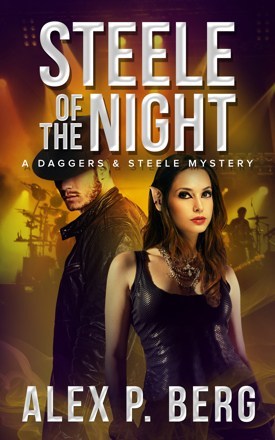
Steele of the Night: In a twist that will surprise absolutely no one who’s read it, this novel was modeled after the movie The Hangover, though I added a fun 1980’s hard rock flair to it as well. Daggers and Steele traipse all over the city as they try to piece together the timeline of a hard rock band’s all-night bender, and the results get predictably wild in more ways than one. This book features the most off-the-wall murder weapon of any in the series (if you could even call it a weapon), but more than the mystery, it features Daggers maturing as he helps Steele through a challenging professional stretch.
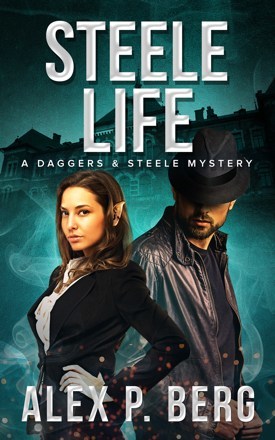
Steele Life: All my Daggers and Steele entries have something fun to offer, but of them all, Steele Life is my favorite. It’s hard to explain why exactly. The premise for the novel is fairly straightforward. It’s a classic whodunit with Daggers and Steele trapped in the lavish home of a wealthy family where everyone is a suspect for the missing matriarch’s murder. The setting isn’t unique, either, but some of the supernatural elements are certainly off the beaten path. I think it’s the number of twists and how they weave together, all the way until the final confrontation, that really does it for me. That and the ending that wraps almost everything up, while leaving some lingering what if questions in the air for the reader to ponder. Even as the book’s author, elements of this one kept me up at night. Hopefully it does the same for you.
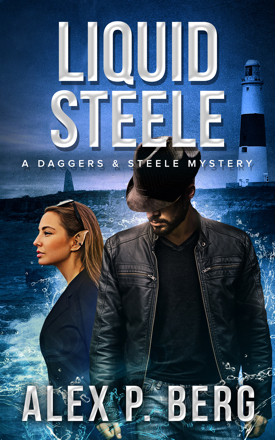
Liquid Steele: Up until this novel, Daggers and Steele had never left New Welwic, but in Liquid Steele I finally got a chance to place the team in a novel setting. This gave me an opportunity to introduce new villains, long lost friends and family, as well as a rival police jurisdiction that (mostly) plays nice with Daggers and Steele. This one features less elements of the supernatural and more elements of a traditional mystery, but once again, it’s Daggers’ personal growth that is the most important. He finally gets a grip on who he is and what he wants, which perfectly sets up the story in…

Man of Steele: The thrilling conclusion to the entire series! It’s the longest book in the series, which makes sense given all that happens between the covers, but ultimately I couldn’t be happier with how this novel, and the series as a whole, turned out. This final entry features loads of thrills, a few chills, lots of intrigue and suspense, as well as several throwbacks to books past, but in the end, it tests Daggers’ mettle and the strength of Daggers’ relationships, not just with Steele, but also with Rodgers, Quinto, and the rest of the crew. And the ending isn’t too shabby either, if I say so myself.
So what’s left for Daggers & Steele? Well, the series has been complete for four years now, and as much as it pains me given fan feedback I’ve received, I don’t have plans to revisit it beyond releasing a Daggers & Steele omnibus (coming very soon!) and maybe a graphic novel, if I can ever find the right artist and scrape up the cash to make that happen. But there is good news! Because while Daggers and Steele’s story might be over, there is a new story waiting to be told. That of their great-granddaughter, one Penelope Phair, who decides to follow in her Nana’s footsteps and join the NWPD. The first novel in the series is called Fair and Just, and it’ll be available for purchase in just a few weeks. Keep your eyes peeled, or sign up to my newsletter to be the first to know!
The post Daggers & Steele: A Six Year Retrospective, Part 3 appeared first on ALEX P. BERG – MYSTERY, FANTASY, & SCIENCE FICTION.
November 2, 2020
Daggers & Steele: A Six Year Retrospective, Part 2
Red Hot Steele was the second novel I ever wrote. I started it on a plane while en route to the first writing conference I would ever attend. I still remember sitting there in an airport while on a layover, tapping away at the keys, feeling absolutely giddy while writing it. Part of that was the thought that I’d learn enough about the business of writing while at said conference to put me on the path to becoming a professional writer, but a larger part, I think, was that the book I was writing was so much fun.
Though I never felt like I’d found an authentic voice while writing my first novel (an epic fantasy), Red Hot Steele felt entirely different. Jake Daggers was a big part of the reason why. He was an inherently flawed character, rude and cocky and sexist among other things, but he was good at his job and there was an honest, decent core to him that made him sympathetic despite his demeanor. To this day, he’s my favorite character I’ve written.
Anyway, in part one of this retrospective, I talked a bit about the origins of the series and reviewed books one and two, Red Hot Steele and Cold Hard Steele. It’s taking me a little longer than I hoped to churn through my rereads of the rest of the series, but here are my thoughts on books three through six, several years after initially penning them:
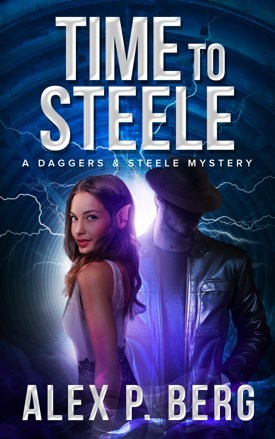
Time to Steele: This was the second and final novel in the series that was inspired by an episode of the TV show Castle, and it was actually the novel I outlined the fastest, taking just three days compared to an average of two to three weeks for most others. It’s also the only novel in the series that features a science fiction element (time-travel) as opposed to a supernatural one, but I nonetheless think the book turned out great. We start to get a sense of what motivates Daggers beyond his jokester persona, and the supporting cast is evolving, too. It’s also the first book I wrote where as the reader you’re not 100% sure you know exactly what happened at the end of the story, which if you’ve read the whole series, you know is a tactic I employed a few more times later on.
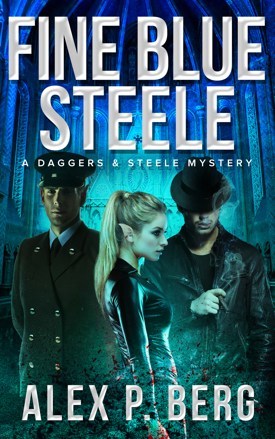
Fine Blue Steele: This novel is the first in the series that throws a wrench into Daggers’ personal story arc. Up until now the relationship between him and Steele had been progressing nicely. Daggers has been learning, evolving, and showing he’s not as one-dimensional as he first presented himself, but in this novel, he stumbles and falls on his face. Even worse, it’s an entirely self-inflicted wound. Though he more or less rebounds by the end of the story, it’s a reminder that he’s a flawed character. He shoots himself in the foot repeatedly, and it’s hard for him not to. Thankfully, Steele realizes this better than he does, which is why she’s such a good foil to him. Also, this novel is the first in which the detectives are solving several different cases simultaneously, even if they don’t know it. It’s also the first that presents some truly mind-bending crime scenes (or the second, depending on how you view the events of Cold Hard Steele). All in all, a great entry.
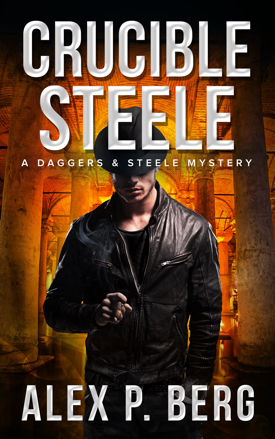
Crucible Steele: As you can probably guess from the cover, this entry in the series is more of a Daggers mystery than a Daggers & Steele one. Daggers is on his own for the lion’s share of this novel, which made it a bit of a challenge to write. As you might imagine, you tend to have more conflict when there are multiple characters in a scene! Also, despite a lot of fans referring to this series as noir urban fantasy, this is the first book in the series that incorporates more traditional noir fiction elements, including tackling themes of police corruption and the blurred line between right and wrong. Daggers’ isolation in this one also means there isn’t much development between him and Steele—at least until the very end, that is. Nonetheless, the way this one wraps up leaves a foundation in place for the next two novels in the series, the first of which is…
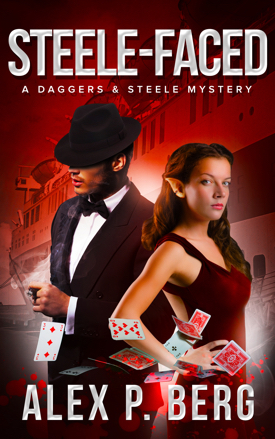
Steele-Faced: This book was inspired by countless poker movies, most notably Casino Royale and Rounders, but of course, given that it’s a Daggers & Steele novel, I had to incorporate my usual supernatural twist. In re-reading it, I have to admit some of the world-building is a little incongruous. I mean, if the city is just getting electrified a few books prior, then it’s probably a stretch to think that a massive, Titanic-like ship was being built at the same time, but I always took liberties in terms of technology levels in this series (something a few people were always quick to remind me of in reviews!) Nonetheless, the real treat in this novel is the evolution of Daggers & Steele’s personal relationship, which culminates in a satisfying encounter. Maybe not the strongest novel of the ten, but a good one nonetheless.
That’s it for this round. Next time, I’ll tackle the final four novels in the series, and see if I can drum up any other insights that I may have overlooked.
– Alex
The post Daggers & Steele: A Six Year Retrospective, Part 2 appeared first on ALEX P. BERG – MYSTERY, FANTASY, & SCIENCE FICTION.
July 27, 2020
Daggers & Steele: A Six Year Retrospective, Part 1
As I sit here in late July of 202o, it’s hard for me to believe that I started work on my first Daggers and Steele novel six and a half years ago. Though Red Hot Steele, my first Daggers & Steele novel, wasn’t the first novel I ever wrote, it was nonetheless my second. The series blew up within a month or two of me self-publishing it, and whatever notoriety I have in the urban fantasy and self-publishing sphere is entirely thanks to Daggers & Steele. All in all, the series has sold almost a quarter of a million copies, and fans are continuing to pick it up and read it to this day. With that in mind, and for reasons I’ll soon reveal, I figured it was high time for me to revisit the series, reread all the entires, and give my thoughts on it, six years and so many books later.
First of all, a little background on the series. For those of you who’ve read it, you know the books take place in the fictional city of New Welwic, an urban metropolis filled with all manner of fantastical creatures and with a technological level of advancement of roughly the 1870s (although there are notable quirks, like the fact that guns haven’t been invented, which many fans pointed out to me in online reviews). So why did I create such an odd world to set my story in? Well, for one, because I loved the idea of taking a traditional fantasy world, advancing the technology, and then telling a different kind of story inside it (a murder mystery, specifically). For another, it was because only one author I knew of had told a similar story: Glen Cook in his Garrett, PI series.
Glen Cook is one of my favorite authors, and his Garrett PI novels are some of his best. I’ve read that series multiple times, but I could never find something that scratched the same itch, so I decided to write some novels of my own that were similar. In fact, one online review once compared me to a poor-man’s Glen Cook, and I took that as a compliment.
My other influence in writing Daggers & Steele was the television show Castle. I loved the relationship between Richard Castle and Detective Kate Beckett, and I put a lot of that into Daggers and Steele’s relationship. To be honest, the plots of my first and third novels were inspired by Castle episodes, which at least one internet sleuth realized, but as I went along I grew more and more comfortable in my ability to tell mysteries pulled entirely from the depths of my own mind.
Regardless, when I started the series I was still quite raw as a writer. With a wealth of experience now at my fingertips, I wanted to go back to those early novels and see what I did that excited people so, as well as see the mistakes I’d made. Over the past couple weeks I’ve re-read my first two entries into the series, and here’s what I’ve learned: (Some spoilers will be present, so read at your own peril. And start reading Daggers & Steele if you haven’t!)
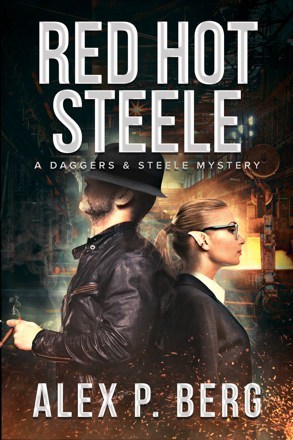
Red Hot Steele: Honestly, it was a little hard for me to read this one so many years later. In many places, the writing felt thin to me. I’d accelerate through scenes with very little description or flesh out parts of the story that could’ve been skipped with a simple scene break. The quality of the writing isn’t up to my current expectations, and there were more than a few grammatical errors I had to weed out of the early versions. In some cases, the characters were a little stereotypical, but nonetheless, I can see why people loved the novel, because in my estimation, I did two important things right.
First of all, I created some great characters. While the supporting cast didn’t get fleshed out until later in the series, Daggers is on full display, and boy is he a piece of work. He’s lazy. He’s cocky. He has relationship problems, work problems, self-esteem problems, drinking problems. He’s a giant ball of problems, and quite honestly, he’s a bit of a jerk. But I was able to show enough of why he’s a jerk to make people sympathize with him, and he turns enough of a new leaf to make you think there’s a good guy inside of him who’s worth learning about for nine more novels.
Second: this book oozed style. Writers and editors always talk about style, and boy does Daggers have it. I’m not entirely sure where I pulled him from, but Daggers’ cynical, lazy worldview infused everything in Red Hot Steele, and it made the world around Daggers come to life, even where I failed to fully flesh it out in other ways.

Cold Hard Steele: Now this is a much better overall book than Red Hot Steele. Daggers’ style is still on full display, from the way he gives random nicknames to victims to his jokes and banter, but the world around him has started to come into focus. Steele, as well as fellow detectives Rodgers and Quinto, are starting to have lives, relationships, hopes, and dreams, rather than being there for the purposes of the plot like they were in Red Hot Steele. Steele is really coming into her own, gaining confidence and challenging Daggers intellectually (as well as emotionally, though she doesn’t know it yet). And the plot is quite good! As I said, this one was a fully original idea, and it shows. Somehow I manage to mix werewolves, doppelgängers, writing groups, and frost magic together into a gripping story that wraps up nicely in the end. From a stylistic standpoint, there was still room for me to grow, and I think I used additional murders as too much of a crutch to draw the detectives forward and unearth more clues for them, but overall this was a great second effort and I can see why the folks who made it to the end of book two mostly stuck around for the rest of the series.
As I finish re-reading more books from the series, I’ll post them here in future installments of my retrospective, but before I part: I did mention I’d reveal why I’m talking about Daggers and Steele in general again. Well… let’s just say that while Daggers and Steele aren’t coming back per se, my next project will still feature them, and any fans of the series are sure to be excited for what’s to come.
Until next time,
Alex
The post Daggers & Steele: A Six Year Retrospective, Part 1 appeared first on ALEX P. BERG – MYSTERY, FANTASY, & SCIENCE FICTION.
January 30, 2020
A YouTube Channel Emerges
I haven’t written a blog in ages. Roughly five years to be precise. It was a conscious choice. Largely I decided that my time was better spent writing products that I could sell, such as books, than those I couldn’t, such as blog posts. But within the last few weeks I’ve started work on a new creative outlet that I wanted to share with those of you here: YouTube.
No, I’m not making videos about my novels or the writing process or anything even related to writing. They’re gaming videos, mostly silly with the intent to entertain rather than inform (though I suppose some of them might be informative, in their own way). Here’s my first month’s worth of videos for you to enjoy. I’ll make an effort to post them every few weeks, but if this sort of entertainment appeals to you, make sure to join my YouTube Channel. It’s called APB Plays, and hopefully you’ll get some laughs out of my content.
Without further ado, my videos thus far:
The post A YouTube Channel Emerges appeared first on ALEX P. BERG – MYSTERY, FANTASY, & SCIENCE FICTION.
October 22, 2015
The One Year Published Author Introspective
If you’ll recall, when I was starting out I published my One Month and Three Month published author introspectives, to give other budding authors an idea of the highs and lows of being an author and perhaps what to expect. I thought about writing one at six months, but instead I waited and decided to do one on the eve (more or less) of my one year anniversary.
Things have changed a lot in a year. At the end of my first month, I was cautiously optimistic. At the end of my third month, I was ecstatic. At a year, I’m more grounded in reality, and while still optimistic, I’m better aware of the challenges of the industry.
With that said, here’s what I’ve learned:
1) eBooks are forever. Sales are not.
At the three month mark, sales were going great, and I was understandably going nuts. Why wouldn’t I? So I tried to project sales going forward. I made what I considered to be a reasonable projection, an optimistic one, and a conservative one. There was just one problem: I was working on three months of data, during a time period in which I released four novels (I’d had a backlog of stuff to publish when I got started). I was riding a massive growth swell. So my projections were understandably off.
Here’s what actually happens when you release a book, though. There’s an initial growth period, where people are hearing about your book through different channels and giving it a try. This growth can be linear or exponential, depending on how lucky you are. Eventually, however, growth turns negative as you reach a greater and greater portion of your target audience through your sales channels. Sales drop, and drop, and drop, unless you do something to change it.
Don’t believe me? Here is the unit sales chart for Red Hot Steele, the first in my Daggers & Steele series and my best-selling novel overall: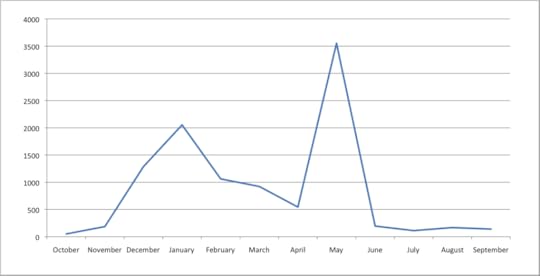
What you see is that sales grew organically for three months, then started to taper off at a regular pace. The massive spike in sales in May is due to a Bookbub promo. I’ll get to that later. You should note, however, that the sales decline trend from January to the present was unaffected by the May promotion.
In indie publishing, there are some who espouse an idea that books are like cash steams. Individually, they don’t make you much money, but put together, a bunch of streams add up into a sizable river of cash.
I don’t think this is a very good metaphor—or at least, it’s not the whole metaphor. The fact of the matter is, when it rains, streams swell into huge torrents, and when it doesn’t, those streams dry up into nothing at all.
Book sales are the same way. Sales can swell quickly. They dry less quickly, but they do dry. And they can dry to almost nothing. If you have dozens of dry streams, they still won’t add up to a river.
With that said, my next bullet point will probably catch you off guard.
2) It’s to your benefit to publish as many books as possible.
Wait, you say. Didn’t you just mention that your book revenue will dry up over time? Why publish lots of books only to create lots of small streams that generate almost no cash flow?
Because you’re not after the tail. I mean, you’ll take it. Any cash from your backlist is nice. But you’re after the cash from the initial growth stage.
The growth period is where you’ll make most of your money from a novel, and that shouldn’t come as a surprise. Movies, video games, traditionally published books, and other media all make most of their money shortly after the initial release, and if they don’t recoup their initial investment quickly, they’re seen as a loss.
I’m not sure if you should be quite so harsh on your own projects (there are ways to revive dead novels and series), but you’ll probably only get a few solid months of earnings from any given release, unless you do something drastic. Speaking of which…
3) The right promotion can make all the difference.
Remember that huge surge in sales in May? That was from a Bookbub promo. If you’re an indie author and you don’t know what Bookbub is, I’ll pause while you go figure it out. Suffice it to say, they’re the most important company out there to help you sell books and make money.
Thanks to the Bookbub promo, I sold over 3500 copies of Red Hot Steele in May, but that doesn’t begin to tell the whole story. Red Hot Steele was priced at a paltry 99¢ for that promotion, but the sales of Cold Hard Steele and the recently released Time to Steele also shot up, and those were listed at full price. That helped me make a lot of money in May.
So while the Bookbub promo couldn’t stop Red Hot Steele’s sales slide, it did earn me a nice chunk of change and earn me a lot of new readers. And Bookbub isn’t the only way to promote your novels. There are many other ways. Bookbub is just one of the best
I don’t want this to turn into a huge ‘How to Promote your Novel’ post, but my point is simply that promoting your novel, if done effectively, will gain you more readers and earn you more money. If making money from your work is your goal (or at least, one of your goals), then you really do need to spend time thinking about promotion.
And last but not least…
4) You’d better be in it for the long haul.
This one doesn’t really fit in with the rest of my tale, but I think it needs to be mentioned. Being an author isn’t easy. It’s full of highs and lows, periods of bounty and periods of drought. You’re constantly learning and trying new things, and if you’re smart, adapting to the marketplace. If you do the same thing for too long, you’ll be left in the dust.
You have to be smart, hard-working, and lucky, and even if you’re all three that doesn’t guarantee success. But it gives you a better shot. So you’d better be committed, otherwise you’ll either never crest the peak in front of you, or you’ll go tumbling down the other side once you get there.
![Pageflex Persona [document: PRS0000032_00033]](https://i.gr-assets.com/images/S/compressed.photo.goodreads.com/hostedimages/1445564192i/16672851.jpg) As for me? I’ve got my crampons on, and I’m climbing this mountain like there’s no tomorrow. But I’m not going to say it doesn’t get a little hairy every now than then.
As for me? I’ve got my crampons on, and I’m climbing this mountain like there’s no tomorrow. But I’m not going to say it doesn’t get a little hairy every now than then.
***
Thanks for reading, and be sure to check out the newly available fourth Daggers & Steele installment: Fine Blue Steele. It’s only been out for one day (one day!) and already it’s reached the number one spot in Amazon’s psychic suspense category. So thank you, readers!
Buy it at: Amazon, iTunes, Barnes & Noble, and Kobo.
The post The One Year Published Author Introspective appeared first on Alex P. Berg.
August 3, 2015
The Complete Guide to Home Audiobook Narration and Production
I’ve been meaning to write this post for a long time. Like, a seriously long time. I think I first mentioned the idea to some friends on Facebook back in April. But I got sidetracked with a book release, and then I got sucked into the writing of a new novel, and so on and so forth. But today I finally submitted my self-produced Red Hot Steele audiobook to ACX for review, and so I figured it was a perfect time to finally write this.
And so, without further ado, I give you: The Complete Guide to Home Audiobook Narration and Production. I think it’ll be a good reference to those of you at home hoping to narrate and produce your own audiobooks (and I bet I’ll refer to it on more than one occasion myself).
One note before we get started: This guide should help you produce audiobooks for any vendor, but I’m specifically focused on producing audio for ACX (Amazon’s subsidiary that uploads to Amazon, Audible, and iTunes). ACX is really the only game in town for indie audio, so it makes sense to focus on them.
OK, first things first. ACX has a series of five videos in which they discuss many of the basic elements of home audiobook production. I HIGHLY encourage you to watch them before you begin here. Seriously. I’ll wait.
Ok. Are you done? Good. Now we can discuss some of the things they mentioned—specifically how to get audiobooks done cheaply and efficiently but professionally. And I’ll give you specific advice on mastering, which the folks at ACX don’t go into.
Space
Let me be blunt. If you don’t have a quiet room in your house that can act as a recording studio, you might as well not even try to record your own audio. This is the most important part of the entire process. If you record in a noisy room, your final product will sound terrible, no matter how hard you try to fix it.
Luckily, many of us have one (and only one) room in our homes that can work.
A walk-in closet.
You see, the key to good audio recording is to do it in a ‘dead room.’ This simply means a room in which sounds don’t bounce around off walls and furniture and play havoc with the audio recorded by your microphone. While professional recording studios will line walls with noise-cancelling foam, it turns out clothing (which is mostly fabric and air) does much the same thing.
 My ‘recording studio.’ Note the copious piles of clothes. I have my wife to thank…
My ‘recording studio.’ Note the copious piles of clothes. I have my wife to thank…I’ve attached a photo of my own recording studio (ie. closet). As you can see, it’s filled with clothes—my wife’s, mostly, but this is how you want it. More clothes means more dampening material. And though you can’t see it, the door to the closet is to the right. When recording, make sure to close the door and drape a thick towel over it. Hard surfaces like doors reflect sound, and you want to avoid any echoes you might get from them.
To see if your closet can work as a studio, you’ll have to try, and we’ll get to that. But first, I want to point out a few things you may have gleaned from the ACX videos. First, be aware of your surroundings as you record. If you can hear dogs barking, birds chirping, children playing, or loud trucks driving by when in the confines of your studio, chances are your microphone will detect those sounds too. Most of the time, you can simply pause your recording if you hear these things and start up again once they’re done.
One thing you must check is to see if your closet has a vent for central heating/air. If it does, I highly recommend you turn it OFF (the entire system, not close the vent) for the length of your recording session. The sound of air forcing through a vent will show up on your recording, and it doesn’t sound good.
And one more point: check to see what kind of lighting you have in your closet. Chances are there’s a fluorescent bulb in there. Those are terrible and make tons on noise. So just bring a small lamp in with you, and make sure to put an LED bulb in it, as LEDs are whisper quiet.
Tools
The ACX guy lists a whole bunch of tools, computer equipment, and software that you should get to optimize your recordings, but quite honestly, the list is excessive, and you don’t need to spend a fraction of what he says you do to produce a quality finished product.
There are really only a few things you need, and I’ll list them here:
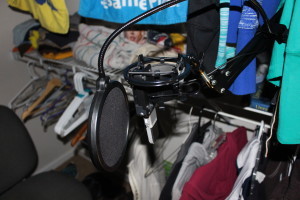 My mic setup. I use the small (but excellent quality) Samson Go Mic.
My mic setup. I use the small (but excellent quality) Samson Go Mic.1. A mic. I recommend a simple USB mic like the Blue Yeti, but even that might be more than is really needed. I use the compact but excellent Samson Go Mic, and it produces great quality sound.
2. A pop filter and a mic stand. Yes, you really do want a pop filter as it noticeably improves sound quality on certain consonant sounds, and a mic stand is critical for optimum positioning. I use this filter and this stand. They’re not expensive.
3. A computer to connect your mic to, preferably a laptop with a solid state hard drive. Why? Because solid state hard drives don’t make noise. Thankfully, I already had a Macbook Air, which is perfect for this sort of thing. (Note the ACX guy says you need a backup hard drive. You don’t. This is purely in case of computer crashes…but it is smart to back up your audio files after every recording session.)
 My computer, running Audacity, and my Kindle, which I use for my readings.
My computer, running Audacity, and my Kindle, which I use for my readings.4. Headphones (in ear or over ear). You’ll need these connected to your computer to avoid having the computer use the standard speakers for output (which will mess up your recording).
5. Something to read your book from. The ACX guy recommends a script stand with a printed script, but you know what I found that I really like? I used my Kindle. It’s backlit, lightweight, and I can switch pages on it faster than I could on a mic stand anyway.
6. Audio recording software. Again, ACX guy says to use Pro Tools, and you could, but it’s expensive. Audacity, on the other hand, is free, it’s available on multiple operating systems, and it works like a charm. In the rest of this guide, I’ll assume you’re using Audacity.
Recording & Narration
You’re now ready to start narrating and recording. First things first, you’ll have to familiarize yourself with Audacity. It’s pretty simple. Just play around with it some. You’ll learn more later at the editing and mastering stages.
There are only a few things you really need to check at this stage, and I’ll refer you to the screenshot I’ve taken.
 The Audacity interface. Note the red numbers 1, 2, and 3.
The Audacity interface. Note the red numbers 1, 2, and 3.See that red number 1 in the lower left corner? Make sure it is set to 44100 Hz. This is the recording rate you’ll want.
See the number 2 at the top right? Make sure you’ve selected the mic you’ve attached via USB, and make sure you’re recording in MONO. Also make sure your headphones are selected.
See the 3 in the top middle? Click on that section to monitor the background noise in your studio. Ideally, you should be at -60dB, but if you’re close, don’t fret. I find that if you’re below -52dB or so, you’ll have no problem editing the background noise out in post processing.
That’s it. You’re ready to record. Just be sure to leave ~20 seconds of silence at the beginning of each chapter you record (you’ll need this for noise reduction purposes later).
Now, let’s talk narration. This is actually one of the hardest parts of the process, as you may not be experienced as a narrator. But you are familiar with your own work, which is a big plus.
Here’s my advice: Practice, practice, practice.
Speak to yourself in a quiet room, at least until you can recite multiple lines of your own work in a row without stutters, stammers, or ums. Don’t worry about flubs during the recording. Just start over at the beginning of a sentence, and keep going. And stay hydrated. A well-lubricated throat is key to precise pronunciation.
A note on character voices: They are essential components of audiobooks, as they give the listener cues as to who is speaking. I can’t give you any advice here other than practice them often, and listen to your own work to make sure they are consistent and unobtrusive (ie. not annoying).
Finally, one last piece of advice. READ SLOWLY. Way slower than you think you should be reading. It takes a lot longer to absorb auditory information than it does to absorb the written word. Go too fast, and your finished product will come across as a blur. Trust me. I had to re-narrate my entire first attempt at Red Hot Steele because I read too fast.
Editing & Mastering
We’ve made it to the last step, which is arguably the trickiest. Editing is simple, but extremely time-consuming and tedious (you’ve been warned!). Mastering is tricky because you probably don’t have any idea how to do it, and it’s easy to mess us the finished product if you’re not careful.
Now, I’m going to say something that will probably make audio engineers cringe, but I like to do the mastering before I do the editing. Why? Because if you edit first and master later, you’ll end up amplifying all sorts of weird, breathy mouth noises and have to go back and edit those out later. So save yourself time and do the mastering first.
Mastering for audiobooks is comprised of (at minimum) three basic steps: noise reduction, compression, and normalization.
Noise reduction removes the background noise from your audio recording (assuming the noise floor is already low). Compression reduces the dynamic range of the audio, so that the loud parts are quieter and the quiet parts are louder. This makes for a more uniform listening experience and makes it so the listener doesn’t have to play with the volume knob often. Normalization limits the maximum loudness or amplitude of a track.
Here are the mastering steps you should take to get a professional finished product that will satisfy ACX submission requirements:
Noise Reduction
Select ~10 seconds of silence at the beginning of the audio recording.
Click on Effect > Noise Removal and click on Get Noise Profile. Hit Ok.
Select the entire audio recording.
Click on Effect > Noise Removal and click Ok.
Compression
Select the entire audio recording and click on Effect > Compressor.
Set the following parameters:
Threshold: -25 dB
Noise Floor: -40 dB
Ratio: 7:1
Attack Time: 0.2 s
Release Time: 1.0 s
Make up gain for 0 dB after compressing checked, Compress based on Peaks unchecked
Alternate Compression (I find that this compresses more and better than step 2 above. Use it instead of step 2 if you decide to go this route.)
Select the entire audio recording and click on Effect > Compress Dynamics (must have optional plug-in, Chris’s Dynamic Compressor, installed. Download it here).
Set the following parameters:
Compress Ratio: 1.0
Compression Hardness: 0.75
Floor: -40.0 dB
Noise Gate Falloff: 0
Maximum Amplitude: 1.0
Normalization
Select the entire audio recording and click on Effect > Normalize.
Check remove DC offset.
Check normalize maximum amplitude and input -3.0 dB.
Once done, you can check the RMS volume of your audio track. Select your entire recording, click on Analyze > Contrast, and then click Measure selection (foreground or background, won’t matter in this case). For ACX, your audiobook track should be between -23dB and -18 dB. If it isn’t, click on Effect > Amplify and play with the values until your track is in the right range.
If there are any wonky spots that are too loud (you’ll see them on the spectrum if they’re there), select them and decrease their volume using the Amplify tool. Then, select all and renormalize.
If you find any spots in your recording that are too quiet, just select them and amplify them individually.
If you’ve gotten this far, that means you’re ready for the editing. It’s simple, really. Just go through your entire recording, deleting bad takes and flubs, silencing any weird mouth sounds or background noise that made it through your noise reduction step, trimming or lengthening pauses between phrases (if necessary), and playing with volume (again, if necessary).
Final Notes
I congratulate you if you’ve made it this far, and hopefully everything I’ve collected here will be of use to you in creating your own audiobooks. But there’s a few final points I wanted to add that didn’t fit in anywhere else, most of them specific to ACX requirements.
Remember to record each track in MONO format at 44.1 kHz.
Record separate opening and closing credits (see this ACX page for more information).
At the beginning of each track, record a chapter header after your initial ~20 second pause, and be sure to leave some room tone (0.5-1.0s at start, 1.0-5.0s at end) in your final finished product.
Export to MP3 format at 192kps, Constant Bit Rate (CBR) in MONO (as long as you record in MONO, Audacity should export in MONO).
Be sure to give all your finished MP3 files a proof listen. Chances are, there will be a few mistakes you’ll have overlooked.
Alright, I think that’s it. Best of luck with your audiobook endeavors, and be sure to check out Red Hot Steele in audio once it’s available (I’ll add the link when I have it).
The post The Complete Guide to Home Audiobook Narration and Production appeared first on Alex P. Berg.
July 30, 2015
Pirates, Kindle Unlimited, and more Amazon Thoughts
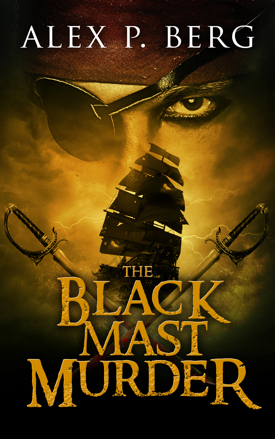 Buy it now on Amazon! Or read for free…
Buy it now on Amazon! Or read for free…So first things first, let’s get the obvious part out of the way. I have a new novel available!
It’s called The Black Mast Murder, and as you might have guessed based on the cover, it’s a pirate novel. But what sort of pirate novel? Grim and dark? Whimsical? Historically accurate?
Well, imagine one of those Pirates of the Caribbean movies, complete with all their mystical, fantastical, grandiose elements. Now add in my own sense of snark and charm (which I’m sure you’re used to by now), mix it all up with a cracking good mystery, and you have yourself The Black Mast Murder.
In all honesty, I’m very proud of this novel. I think the setting will draw you in immediately, and the story has a nice balance of action, mystery, and even its fair share of romance. And you can BUY IT NOW, exclusively on Amazon.
Which, as you may have guessed, means I’ve decided to put the novel into Amazon’s Kindle Unlimited (KU) program.
For those of you unfamiliar with KU, it’s a monthly subscription service that lets people read as many novels as they want, and we (the authors) get paid based on how much you read. To opt into the program, you have to make your ebook exclusive with Amazon, at least in increments of 90 days.
Now, let me be frank. I don’t like exclusivity—even timed exclusivity. I think it usually benefits the distributor, not the author. But the ebook market is changing. More and more readers (especially power readers, who read in large quantities) are shifting to subscription services, chief among them KU, and those authors who ignore them are leaving dollars on the table.
Of course, you can argue that going exclusive also forces you to leave dollars on the table—the dollars you would earn from other retailers. But those dollars are few and far between.
Over 91% of my lifetime ebook sales have been on Amazon. Barnes & Noble has about 4.5%, Kobo about 3%, and Apple/iTunes has brought me a meager 1%. AND those numbers are generous to those other retailers, as the majority of sales I’ve received everywhere other than Amazon came off the back of my successful Bookbub promo. If you exclude the month of May, my lifetime sales are about 96% from Amazon. (And considering that Barnes & Noble’s nook division seems to be going down the tubes, those numbers look likely to continue to worsen in the future.)
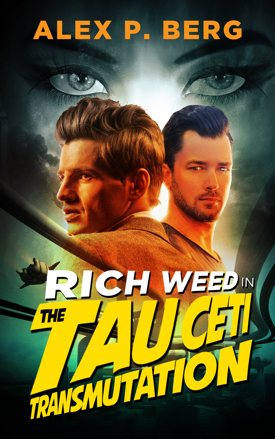 Now available on Kindle Unlimited. Read for FREE!
Now available on Kindle Unlimited. Read for FREE!All of which is to say that I make the VAST amount of my revenue from Amazon, and if there’s a way to increase my Amazon revenue, even at the cost of revenue from other sources, it might make sense. Honestly, if I can earn even half of the amount from Amazon’s KU program as I do from sales, that would still be about five times as much as I make from all other retailers combined.
So what does this mean for you? Not much, probably. You can still buy my work (at a fantastic, low price, I might add!), but if you’re a member of Amazon’s Kindle Unlimited monthly reading program, you can actually read The Black Mast Murder for FREE!
And at the risk of sounding like a used car salesman…wait, there’s more! Remember my science fiction P.I. novel, Rich Weed in The Tau Ceti Transmutation? Well, it’s also exclusive to Amazon now, and those of you in KU can read that for FREE too!
(Side note: My Daggers & Steele series continues to be available everywhere, for the time being anyway. Consider this a test. If my novels in KU do great, I might move everything there. If not, the exclusive titles will be made available everywhere. I’ll decide in about 90 days…)
One last note, before I go. You’ve probably noticed the link up at the top of my website encouraging you to join my new release mailing list. It’s the easiest way for me to tell you about my new novels. But, understandably, many people don’t like signing up for tons of lists. Our inboxes are cluttered enough as it is.
Well, Amazon has once again come to the rescue. Check out my Amazon author page. See that yellow button underneath my photo, the one that says “Follow”? If you click that, Amazon will let you know when I release new books. Why trust me with your email address when you can trust a massive, multinational corporation? (I kid, of course…) But nonetheless, it’s a neat feature, and if for some reason you’d rather not give me your email, why not give the Amazon Follow feature a try?
The post Pirates, Kindle Unlimited, and more Amazon Thoughts appeared first on Alex P. Berg.



